Your living room isn’t just a space—it’s the heart of your home.
It’s where laughter echoes during family movie nights, guests gather for celebrations, and quiet moments of reflection happen over a cup of coffee. In 2025, home has taken on even greater importance, becoming a sanctuary that blends comfort, functionality, and style.
So, if your living room feels a little outdated or lacking personality, this guide is for you. Whether you’re working with a small space, a tight budget, or just a case of creative block, we’ve curated the best expert-approved living room styling ideas to help you completely reimagine your space.
Get ready to discover practical tips, design inspiration, and clever styling secrets that interior designers swear by.
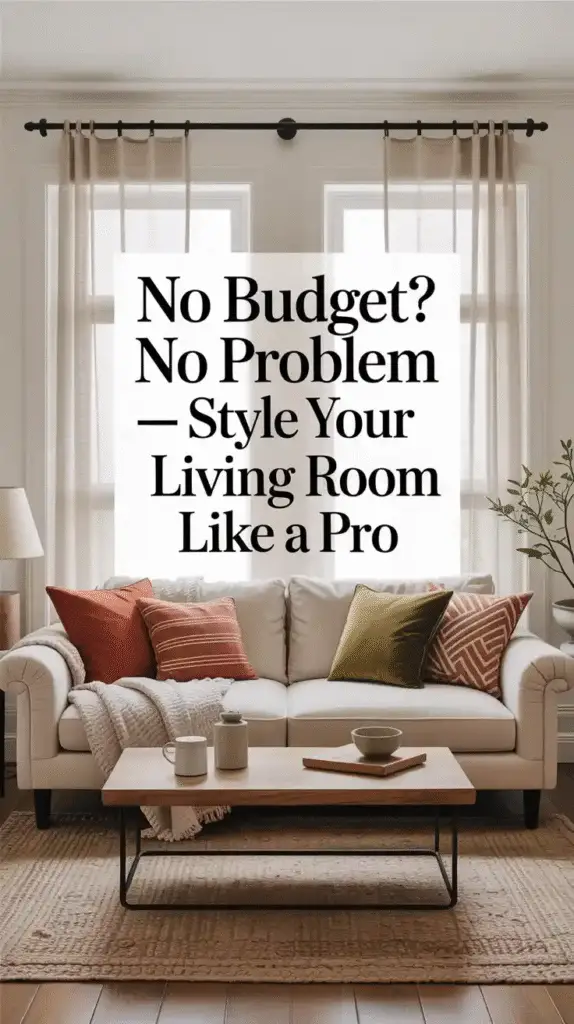
Understanding Your Living Room’s Potential
The Psychology of Space: How Layout Affects Behavior
Ever notice how some rooms instantly feel cozy while others feel… off? That’s not a coincidence.
The way your furniture is arranged, how light flows through the room, and the visual balance all affect your mood and behavior. A cluttered or poorly arranged room can lead to discomfort or even stress—while a thoughtfully styled one can foster relaxation and creativity.
So before you start buying decor, think about how you want to feel in your space. Energized? Calm? Inspired?

Identifying Your Style: Modern, Farmhouse, Boho, Minimalist, or Eclectic?
Your style doesn’t need to fit in a box, but knowing what aesthetics speak to you can guide your decisions.
Here are a few popular styles in 2025:
- Modern: Clean lines, neutral colors, minimal accessories.
- Boho: Layered textures, global patterns, earthy tones.
- Farmhouse: Cozy, rustic charm with wood accents.
- Scandinavian: Light woods, simplicity, functional beauty.
- Eclectic: A curated mix of styles, colors, and eras.
💡 Tip: Create a Pinterest board with your favorite living rooms. You’ll start noticing patterns in colors, shapes, and layouts.

Assessing Your Current Setup: What’s Working and What’s Not?
Take a good look at your living room. Ask yourself:
- Do I have enough natural light?
- Does the furniture feel cramped or oversized?
- Is there a clear focal point?
- Do I love the colors and textures I’m seeing?
Write down what feels “off” and what already feels good—this will be your styling roadmap.
Setting a Foundation – Start with a Plan
Measuring Your Space Like a Pro
Grab a tape measure, a notebook (or a free app like RoomSketcher), and document:
- Room length and width
- Ceiling height
- Window dimensions
- Door swings
- Location of outlets and vents
Why? Because buying a sofa that looks perfect online and realizing it blocks your window in real life is the stuff of interior design nightmares.

Creating a Mood Board (Tools & Examples)
Use Canva, Pinterest, or good old Photoshop to pull together a vision board.
Include:
- Color swatches
- Fabric samples
- Photos of furniture pieces you love
- Lighting fixtures
- Inspiring rooms from Instagram or magazines
This board keeps your vision focused and helps avoid impulse buys that clash with your style.
Budgeting Without Compromising Style
Here’s how to create magic on any budget:
- High-impact, low-cost upgrades: Paint, throw pillows, rugs.
- Mix high & low: Splurge on a signature sofa, save on side tables.
- Secondhand gems: Facebook Marketplace, estate sales, or thrift shops often have quality furniture at a fraction of the price.
Living Room Layout Ideas That Actually Work
Classic vs. Open Concept Layouts
If you’re working with a closed-off room, anchor the space around a central point (like a fireplace or TV). Symmetry works well here.
In an open concept layout, define zones. Use rugs, sectional sofas, or console tables to visually separate the living room from the kitchen or dining area.
Focal Point Design: TV, Fireplace, or a Gallery Wall?
Every stylish room has a clear focal point:
- Mount a sleek TV above a minimalist console
- Highlight your fireplace with tile or shiplap
- Create a gallery wall with curated art or family photos
But don’t try to compete—choose one focal point and let it shine.

Zoning the Space: Conversation Areas, Reading Nooks & More
Especially in large rooms, break the space into zones:
- Conversation corner: Two chairs + side table
- Reading nook: Armchair + lamp + bookshelves
- Workstation: Compact desk by a window
It’s all about intentional space usage without overcrowding.
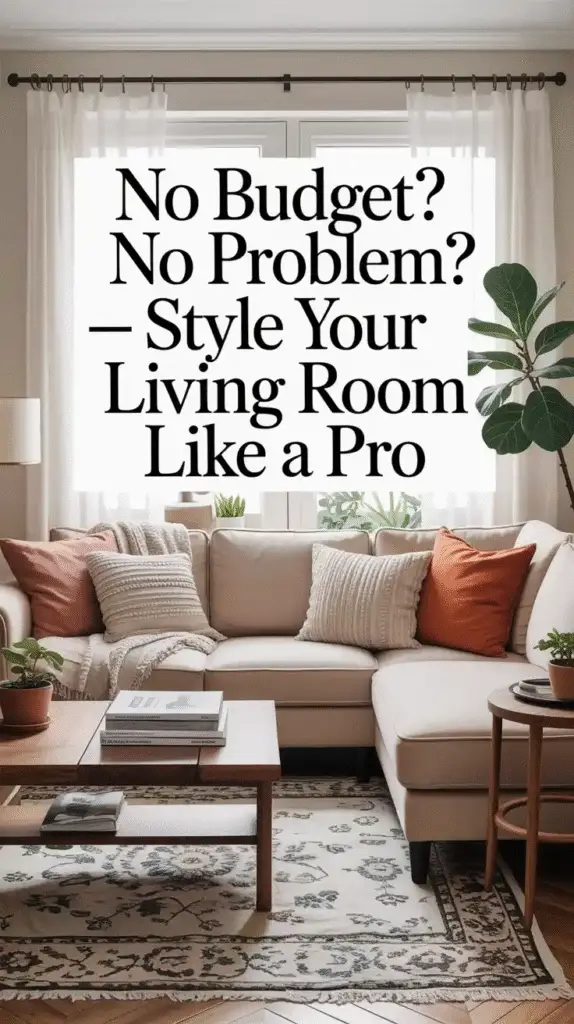
Choosing the Right Color Palette
2025 Trending Colors for Living Rooms
Expect to see:
- Earthy greens (sage, olive)
- Warm neutrals (taupe, sand)
- Muted terracottas
- Moody blues
- Soft blacks as a grounding accent
These hues are cozy, sophisticated, and incredibly versatile.
Timeless Neutrals vs. Bold Accents
A neutral base gives you endless flexibility. Think beige walls, cream sofas, or light wood floors. Then, bring in drama with:
- Bold art pieces
- Jewel-toned pillows
- Colorful rugs or drapes
Want a moody look? Try dark walls balanced with light, reflective surfaces.
How Lighting Affects Paint Choices
Natural light can drastically change how a color looks.
- North-facing rooms may need warmer tones to balance cool light.
- South-facing rooms can handle bolder, darker shades.
Always test samples on multiple walls before committing!
Tips for Using Two-Tone Walls and Accent Walls
Two-tone walls are trending—think bottom half in rich navy, top in crisp white. It adds visual interest without being overwhelming.
Accent walls work best when:
- There’s a natural focal point (like behind the sofa or TV)
- You use texture (wood slats, wallpaper) instead of just paint
Furniture Selection & Placement
Sofas: Choosing the Right Size, Shape, and Upholstery
Your sofa is the star of the living room—it sets the tone and anchors your design. Choose based on your:
- Space size – In a small room, a sleek mid-century sofa works better than an oversized sectional.
- Lifestyle – Do you entertain? Have kids or pets? Go for durable performance fabric like microfiber or Crypton.
- Design taste – Modern spaces may call for structured, clean-lined silhouettes. Cozy, traditional rooms do well with rolled arms and plush cushions.
📌 Pro Tip: Leave at least 18 inches between the coffee table and the sofa edge for legroom.
Coffee Tables & Side Tables: Styles That Work Together
The coffee table isn’t just for placing mugs or remotes. It adds style, structure, and personality.
- Go for round tables in tight spaces—they’re easier to navigate around.
- Use nesting tables for flexibility and movement.
- Try mixing materials: a marble top + brass base = instant luxury.
Side tables are your styling secret weapons. Choose:
- Mismatched sets for an eclectic feel
- Matching sets for symmetry and polish
Accent Chairs, Ottomans & Benches for Versatility
Accent chairs are a designer’s best friend:
- Add a pop of color
- Create reading corners
- Introduce contrasting textures
Ottomans can double as:
- Extra seating
- A footrest
- Hidden storage (look for lift-top designs)
Benches? Perfect under windows, behind sofas, or at the entry of an open-plan room.
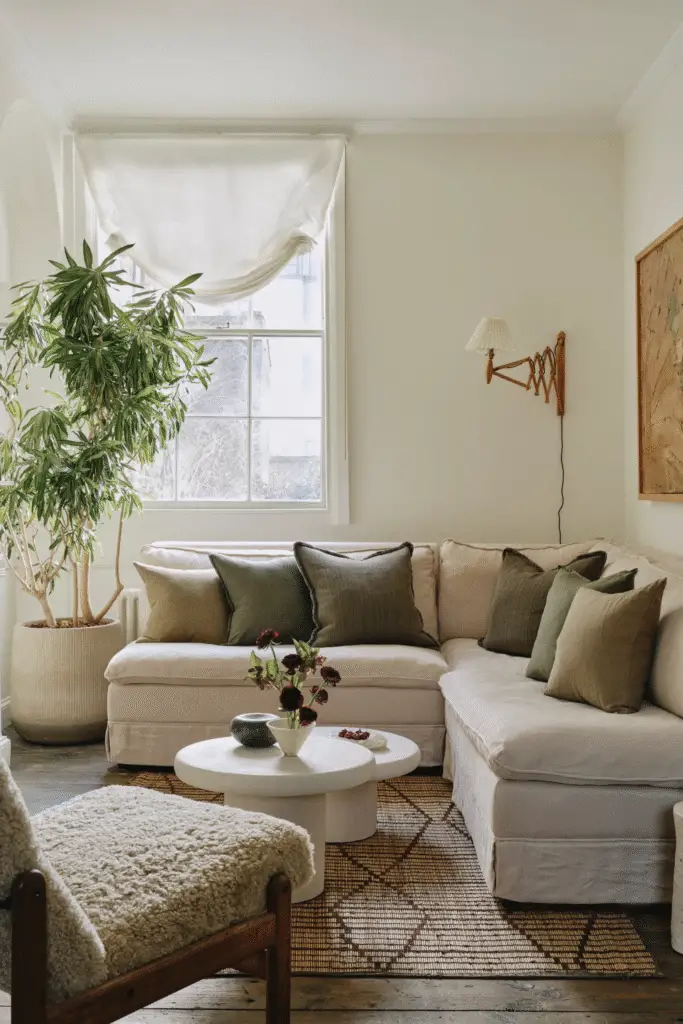
Sectional vs. Separate Seating: Pros and Cons
| Feature | Sectional | Separate Seating |
|---|---|---|
| ✅ Great for large families | ✅ More flexible for rearranging | |
| ✅ Creates defined zones in open floor plans | ✅ Easier to move & replace | |
| ❌ Harder to fit in smaller rooms | ❌ May not seat as many |
In small rooms, consider a loveseat + two chairs instead of a full sectional.
Floating Furniture: Is It Right for You?
Pushing your sofa against the wall may seem like the best idea—but floating furniture often looks more intentional and designer-worthy.
Leave space behind the sofa for:
- A console table with lamps and decor
- A walkway to another zone of the room
Floating arrangements work best when:
- The room is large enough to allow for walkways
- You use a rug to ground the space and create borders
Styling with Rugs & Flooring
Choosing the Right Rug Size (with examples)
Get this wrong, and the whole room feels off-balance. Here’s the golden rule:
🧠 All front legs of your furniture should be on the rug.
Standard Sizing Tips:
- 5’x8’ for small living rooms
- 8’x10’ or 9’x12’ for medium to large living rooms
- Go even larger if you have a sectional—don’t be afraid to size up
Layering Rugs for Depth
This designer trick adds texture, warmth, and visual interest:
- Start with a neutral base rug (jute or sisal)
- Add a smaller patterned rug on top
- Offset the top rug slightly for a more organic look
It’s budget-friendly too—smaller statement rugs are often cheaper.
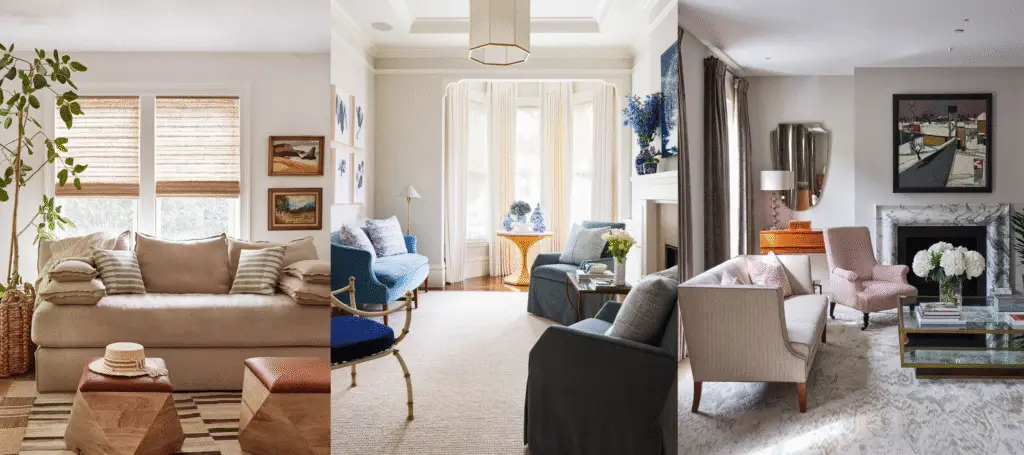
Rug Placement Tips for All Layouts
Whether your layout is symmetrical or more free-form, rug placement can guide the eye and ground the space:
- Center it under your coffee table
- Keep at least 12–24 inches of space between rug edge and wall
- Use runners behind sofas or near doorways to create pathways
Best Flooring Types for Stylish Living Rooms
If you’re renovating or upgrading, consider:
- Luxury vinyl planks (LVP): Affordable, durable, and looks like hardwood
- Engineered hardwood: Classic and warm
- Polished concrete: Ultra-modern and minimalist
- Layered carpet tiles: Great for kids’ zones or renters
Don’t forget area rugs can soften any hard flooring instantly.
Window Treatments That Wow
Curtains vs. Blinds vs. Shades: What’s Best?
- Curtains: Add softness and drama. Use floor-to-ceiling drapes to make ceilings look taller.
- Blinds: Sleek and practical. Great for privacy and light control.
- Shades (Roman, roller, bamboo): Blend function and style effortlessly.
Pro styling tip: Double up with both shades and curtains for depth and luxury.
How to Hang Curtains for a Luxe Look
- Hang high and wide – Place curtain rods 6–12 inches above the window frame and extend 6–12 inches beyond each side.
- Let curtains kiss the floor or even puddle slightly for elegance.
- Use thicker curtain rods with strong finials for added impact.
Color and Fabric Choices for Different Moods
| Mood | Suggested Fabric & Colors |
|---|---|
| Cozy & warm | Velvet in earth tones |
| Light & airy | Linen in soft neutrals |
| Bold & dramatic | Patterned cotton in dark hues |
| Calm & serene | Sheer whites or pastel blues |
Mix patterns and solids to add dimension, but keep a unifying theme or tone.
Lighting Design Like a Pro
Layered Lighting: Ambient, Task & Accent
- Ambient lighting – The main source of light (ceiling fixture or recessed lights)
- Task lighting – Table lamps, floor lamps for reading or working
- Accent lighting – Spotlights, sconces, or under-shelf lighting for mood
🛋️ Your goal: Every corner of your living room should have purpose and light.
Statement Chandeliers and Modern Ceiling Lights
No more boring ceiling fans—2025 calls for bold, sculptural fixtures:
- Sputnik chandeliers
- Oversized woven pendants
- Geometric LED fixtures
These act as both lighting and art, and they instantly upgrade your room’s style.
Wall Sconces and Floor Lamps That Add Personality
Wall sconces save space and create ambiance. Use them to:
- Frame art
- Flank a fireplace
- Highlight a reading nook
Floor lamps add drama and height. Try arched styles that hover over your seating for modern elegance.
Smart Lighting Tips for Ambiance Control
Lighting isn’t just practical—it sets the vibe.
- Use dimmers to adjust brightness based on time of day or mood.
- Install smart bulbs (like Philips Hue) for color-changing options.
- Use warm white (2700K–3000K) bulbs for a cozy, welcoming glow.
Creating a Functional Yet Beautiful Space
Kid-Friendly Styling Without Sacrificing Aesthetics
Yes, you can have a beautiful living room even with toddlers running around!
Here’s how:
- Choose rounded furniture (no sharp corners)
- Go for stain-resistant fabrics
- Add storage ottomans for toys
- Use washable rugs like Ruggable
Pet-Proof Fabrics and Furniture Options
Furry friends welcome—but your furniture shouldn’t suffer.
Best choices:
- Microfiber and leather (easy to clean and resist pet hair)
- Slipcovered sofas (washable and replaceable)
- Tightly woven rugs (harder for claws to snag)
Avoid boucle, velvet, or loose-weave fabrics unless your pets are chill.
Storage Ideas: Stylish Baskets, Hidden Compartments & Built-ins
Storage doesn’t have to be boring:
- Use wicker baskets under coffee tables or consoles
- Choose a TV stand with cabinets
- Incorporate built-in shelves for a high-end, custom look
- Try multi-use furniture like lift-top coffee tables or bench seats
Seasonal Styling Tips
Your living room doesn’t have to look the same year-round. Switching things up with the seasons keeps your space fresh and exciting. Here’s how to style seasonally without a full makeover:
Cozy Fall Decor for Your Living Room
- Swap light throws for chunky knits in warm shades like rust, mustard, and olive.
- Add fall-scented candles (think cinnamon, pumpkin spice, or cedarwood).
- Layer in plaid or flannel throw pillows.
- Use natural elements like dried wheat, pinecones, and mini pumpkins on the coffee table.
Winter Wonderland Vibes with Soft Textures
- Bring out faux fur throws, velvet pillows, and plush area rugs.
- Decorate with twinkle lights, lanterns, and pine garlands for a festive glow.
- Incorporate silver, gold, and deep jewel tones for a luxe winter feel.
- A cozy reading corner with a floor lamp and a stack of books adds winter charm.
Spring Refresh Ideas with Florals and Color
- Introduce fresh pastels—blush pinks, mint greens, or light blues.
- Display fresh-cut flowers or branches in a statement vase.
- Swap out heavy fabrics for light cottons and linens.
- Add bright artwork or new pillow covers to wake up your space.
Summer Styling: Light, Bright & Breezy
- Opt for tropical prints and bright citrus colors.
- Remove heavy curtains—try sheer panels or natural bamboo shades.
- Use woven textures: rattan trays, jute rugs, cane furniture.
- Add seashells, driftwood, and beachy candles for a coastal vibe.
Small Living Room Styling Ideas
Styling a small living room? Don’t worry—smart design can make it feel twice as big.
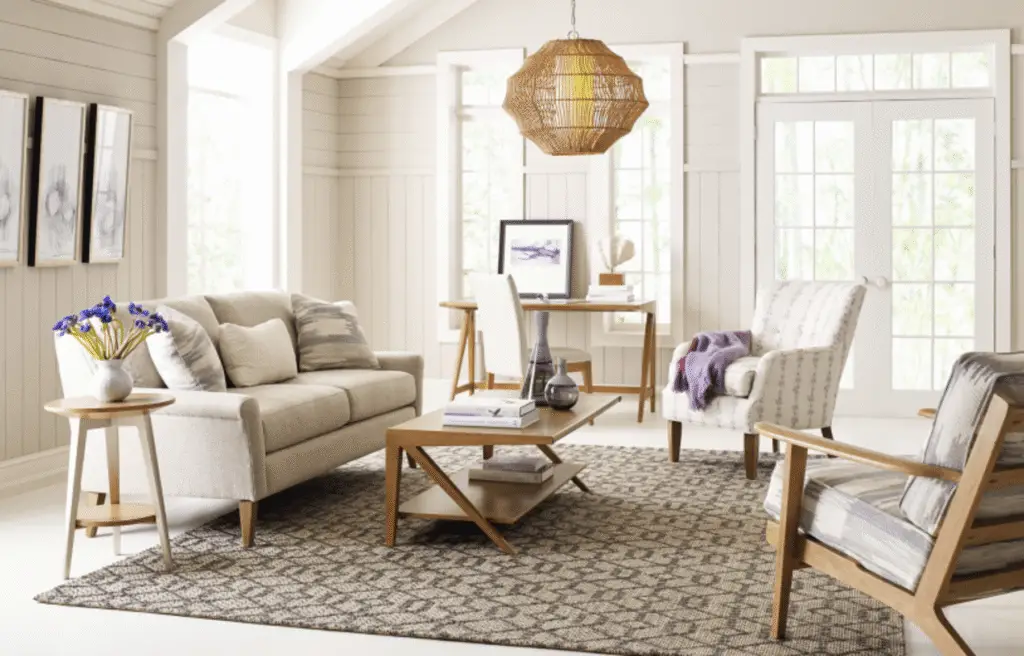
Space-Saving Furniture Choices
- Choose armless chairs, loveseats, or modular furniture.
- Opt for multi-purpose pieces like storage ottomans or nesting tables.
- Use glass or acrylic tables that visually disappear.
Using Vertical Space Effectively
Walls are your best friends in small rooms:
- Add floating shelves for books, plants, and decor.
- Try tall, slim bookshelves instead of bulky low ones.
- Hang tall mirrors to draw the eye upward.
Mirrors and Light Tricks to Make it Feel Bigger
- Place a large mirror across from a window to bounce light around.
- Use light colors on walls and floors to open up the space.
- Keep the room clutter-free and airy—edit your accessories!
Compact Yet Cozy Layout Designs
- Float a small sofa in the center with a slim console behind it.
- Create a conversation area with two armchairs angled inward.
- Mount the TV on the wall to save floor space.
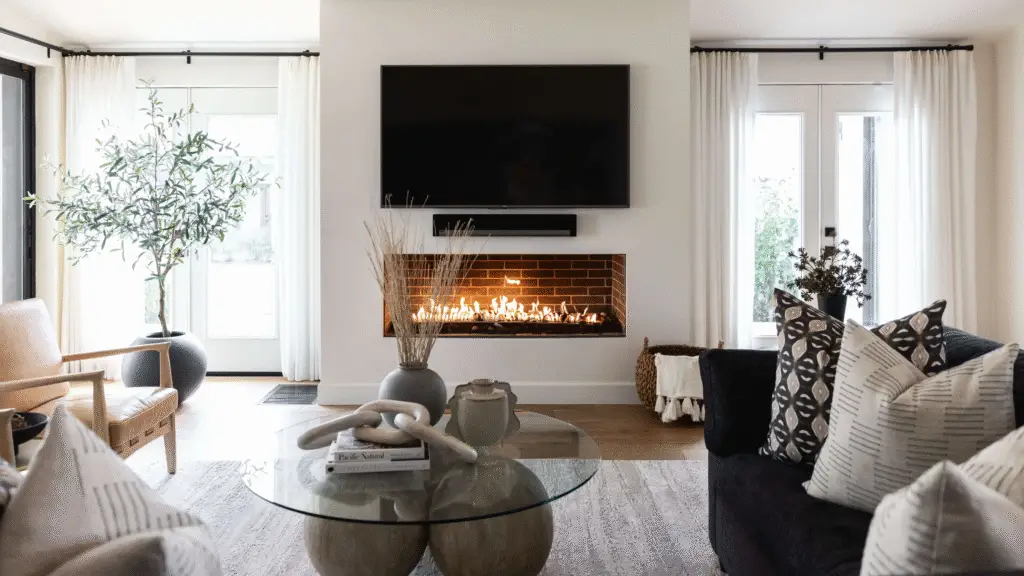
Common Styling Mistakes to Avoid
Even beautiful decor can fall flat when certain mistakes are made. Here are a few to watch out for:
Overcrowding the Room
Too much furniture = a cramped feel. Leave breathing room. Follow the “less but better” rule.
Ignoring Scale and Proportion
That giant sofa might look great online, but if it overpowers your room, it’ll throw everything off. Measure and scale items appropriately.
Mismatched Styles Without Cohesion
Mixing styles is fun—but you need a common thread. Use consistent color palettes or repeating materials (like gold hardware or wood tones) to tie everything together.
Lighting That Doesn’t Match the Mood
Overhead lighting alone is harsh. Always layer with lamps or wall sconces. Don’t forget dimmers for flexibility.
Real-Life Makeover Examples
Here’s how real people are transforming their living rooms—with smart styling, not massive budgets.
Before & After Styling Case Studies
Example 1: Small Apartment Makeover
- Before: Cluttered space with mismatched furniture.
- After: Streamlined mid-century furniture, cohesive neutral palette, floating shelves, and a large rug to anchor the room.
Example 2: Budget Refresh
- Before: Dark and outdated decor.
- After: White walls, sage green accents, thrifted cane armchair, modern artwork, and plants to brighten everything up.
Designer-Approved Styling Ideas from Pinterest
- Use asymmetrical gallery walls for a more artistic, modern look.
- Layer textiles—a flatweave rug over a jute base instantly adds depth.
- Try a bold accent wall behind the TV or fireplace with rich, moody paint or wood slats.
Budget vs. Luxe Styling Comparisons
| Feature | Budget-Friendly | Luxe Alternative |
|---|---|---|
| Sofa | IKEA or Wayfair | West Elm or Article |
| Rug | Ruggable | Loloi or CB2 |
| Coffee Table | Facebook Marketplace | Crate & Barrel |
| Art | Printable downloads | Framed originals or canvas prints |
| Decor | Target or H&M Home | Serena & Lily or Anthropologie |
Remember: Style isn’t about price—it’s about intention.
Frequently Asked Questions
What Is the Best Way to Style a Small Living Room?
Use space-saving furniture, keep walls light, and don’t overdecorate. Use mirrors and strategic lighting to open it up.
How Can I Style My Living Room on a Budget?
- Rearrange what you already own
- Add new throw pillows and plants
- Use peel-and-stick wallpaper or paint for a quick refresh
- Shop secondhand for statement pieces
Should the Living Room Match the Rest of My House?
Yes and no. Aim for a cohesive overall feel, but your living room can have its own identity. Use colors or materials that echo other rooms to create flow.
How Often Should I Refresh My Living Room Decor?
You don’t need to redo everything often. A seasonal refresh every 3–4 months with small items (pillows, art, rugs) can make your space feel brand new.
✅ Final Styling Checklist
Before you say “done,” review this final styling checklist:
✅ Focal point defined
✅ Balanced furniture layout
✅ Proper rug size and placement
✅ Layered lighting (ceiling, floor, table)
✅ Coordinated but interesting accessories
✅ Curtains hung high and wide
✅ Seasonal elements added
✅ Personal touches (photos, heirlooms, unique finds)
✅ Zero clutter—every item earns its place
Conclusion: Your Living Room, Reimagined
Styling your living room isn’t about following trends—it’s about telling your story through furniture, color, texture, and light. Whether you love soft minimalism or bold boho layers, 2025 is the year to own your style.
So take it slow, stay inspired, and remember: a well-styled home doesn’t need to be perfect. It just needs to reflect you.
💬 Now It’s Your Turn!
What’s your biggest living room styling struggle? Share your thoughts in the comments below or pin this guide to your Pinterest boards to revisit later. Let’s keep the inspiration going!

